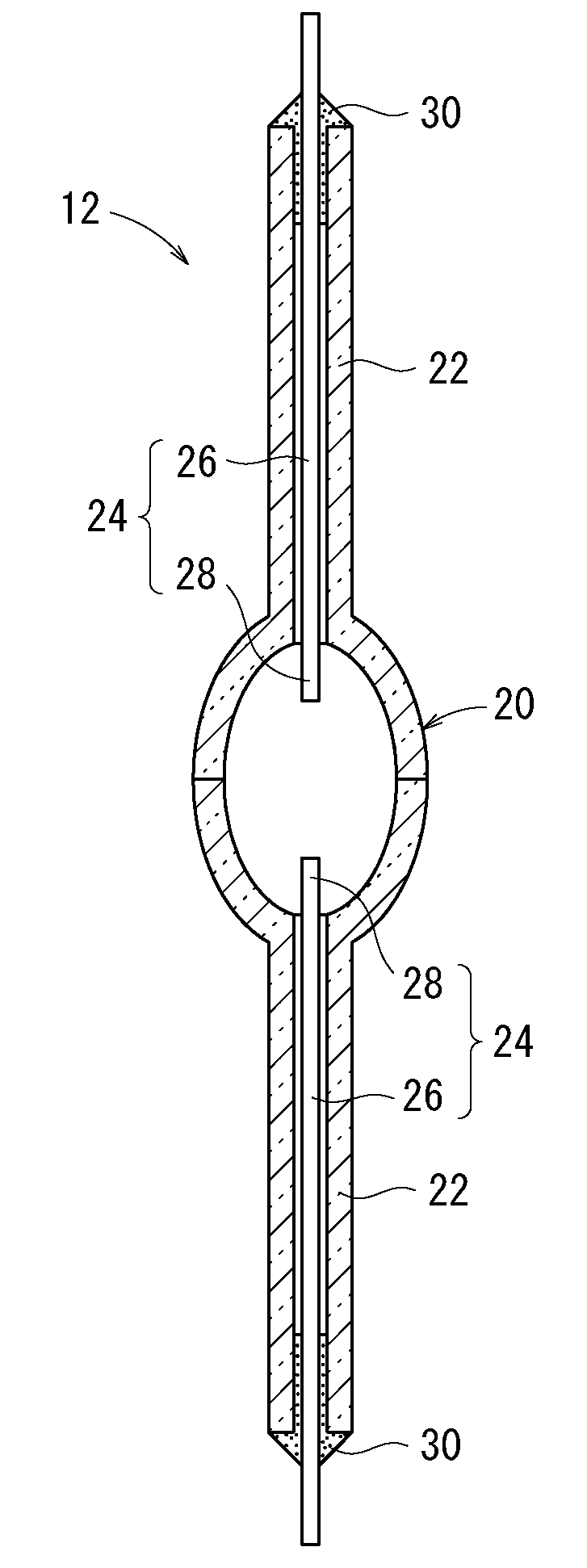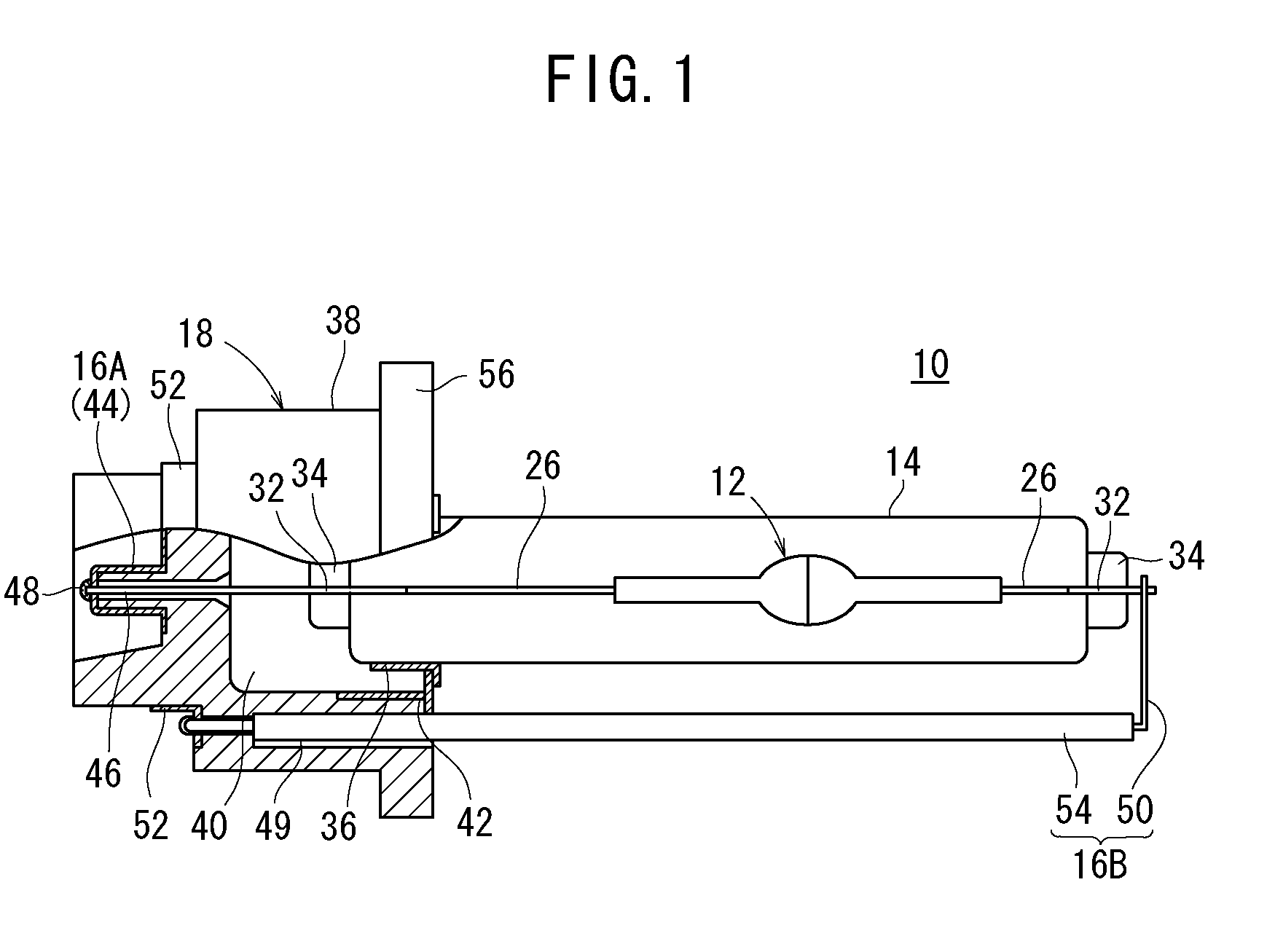Translucent polycrystalline sintered body, method for producing the same, and arc tube for high-intensity discharge lamp
a technology of translucent polycrystalline sintered body and arc tube, which is applied in the direction of gas-filled discharge tubes, solid cathodes, domestic applications, etc., can solve the problems of poor in-line transmittance of arc tube of conventional translucent alumina, inferior qualities of conventional ceramic bodies using only mgo, and inability to produce satisfactory results, etc., to achieve high in-line light transmittance, high bending strength, and high translucency
- Summary
- Abstract
- Description
- Claims
- Application Information
AI Technical Summary
Benefits of technology
Problems solved by technology
Method used
Image
Examples
example 1
[0122]A slurry was prepared by mixing the following components.
[0123]100 parts by weight of an α-alumina powder having a specific surface area of 3.5 to 4.5 m2 / g and an average primary grain diameter of 0.35 to 0.45 μm
[0124]0.025 parts by weight of MgO (magnesia)
[0125]0.040 parts by weight of ZrO2 (zirconia)
[0126]0.0015 parts by weight of Y2O3 (yttria)
(Dispersion Medium)
[0127]27 parts by weight of dimethyl glutarate
[0128]0.3 parts by weight of ethylene glycol
(Gelling Agent)
[0129]4 parts by weight of an MDI resin
(Dispersing Agent)
[0130]3 parts by weight of a macromolecular surfactant
(Catalyst)
[0131]0.1 part by weight of N,N-dimethylaminohexanol
[0132]The slurry was cast into an aluminum alloy mold at the room temperature. The slurry was left in the mold at the room temperature for 1 hour and at 40° C. for 30 minutes to perform solidification. The resultant solid was separated from the mold, and was let stand at the room temperature for 2 hours and at 90° C. for 2 ...
example 2
[0139]A slurry was prepared in the same manner as Example 1 except for using 0.0030 parts by weight of Y2O3.
[0140]The slurry was cast into an aluminum alloy mold at the room temperature. The slurry was left in the mold at the room temperature for 1 hour and at 40° C. for 30 minutes to perform solidification. The resultant solid was separated from the mold, and was let stand at the room temperature for 2 hours and at 90° C. for 2 hours, to obtain plate-shaped and rod-shaped powder compacts.
[0141]Each of the obtained powder compacts was calcined at 1100° C. in the air, and fired twice at 1800° C. in a hydrogen / nitrogen ( 3 / 1) atmosphere, to increase the density and translucency of the compact. Thus, a plate-shaped sintered body, an arc tube-shaped sintered body, and a rod-shaped sintered body, respectively having the same sizes as those of Example 1 were produced.
[0142]The average grain diameter of each sintered body was measured by the above described average grain diameter calculati...
example 3
[0147]A slurry was prepared in the same manner as Example 1 except for using 0.0045 parts by weight of SiO2 (silica), 0.003 parts by weight of Na2O (sodium oxide), and 0.002 parts by weight of K2O (potassium oxide) in addition to the components of Example 1.
[0148]The slurry was cast into an aluminum alloy mold at the room temperature. The slurry was left in the mold at the room temperature for 1 hour and at 40° C. for 30 minutes to perform solidification. The resultant solid was separated from the mold, and was let stand at the room temperature for 2 hours and at 90° C. for 2 hours, to obtain plate-shaped and rod-shaped powder compacts.
[0149]Each of the obtained powder compacts was calcined at 1100° C. in the air, and fired once at 1800° C. in a hydrogen / nitrogen ( 3 / 1) atmosphere, to increase the density and translucency of the compact. Thus, a plate-shaped sintered body, an arc tube-shaped sintered body, and a rod-shaped sintered body, respectively having the same sizes as those o...
PUM
| Property | Measurement | Unit |
|---|---|---|
| Temperature | aaaaa | aaaaa |
| Temperature | aaaaa | aaaaa |
| Temperature | aaaaa | aaaaa |
Abstract
Description
Claims
Application Information
 Login to View More
Login to View More - R&D
- Intellectual Property
- Life Sciences
- Materials
- Tech Scout
- Unparalleled Data Quality
- Higher Quality Content
- 60% Fewer Hallucinations
Browse by: Latest US Patents, China's latest patents, Technical Efficacy Thesaurus, Application Domain, Technology Topic, Popular Technical Reports.
© 2025 PatSnap. All rights reserved.Legal|Privacy policy|Modern Slavery Act Transparency Statement|Sitemap|About US| Contact US: help@patsnap.com



